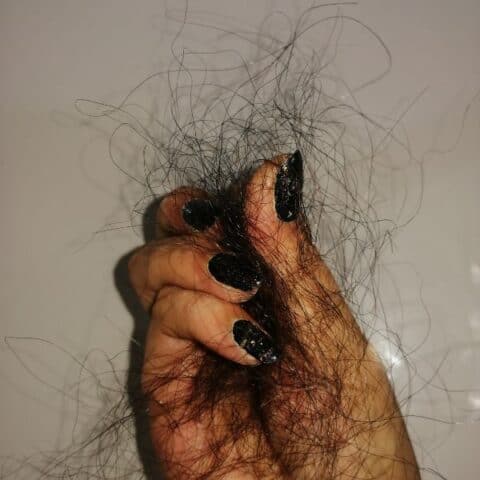Alopecia areata is a condition that affects the hair follicles, leading to hair loss in specific areas of the body. While the most noticeable symptom of alopecia areata is the loss of hair on the scalp, there are also other signs and symptoms that can be observed, including changes in the fingernails.
This article aims to explore the relationship between fingernails and alopecia areata, what these changes in the nails can indicate, and how they can be used in the diagnosis and management of the condition.

Understanding Alopecia Areata
Alopecia areata is an autoimmune disease that occurs when the body’s immune system mistakenly attacks the hair follicles, resulting in hair loss. The exact cause of this condition is still unknown, but experts believe that it could be a combination of genetic and environmental factors. Alopecia areata can occur at any age, and both men and women are equally affected.
The Science Behind Alopecia Areata
Researchers have found that alopecia areata is caused by an autoimmune response, where the immune system mistakenly targets the hair follicles. This leads to inflammation, which in turn disrupts the normal hair growth cycle. As a result, the affected hair follicles enter a resting phase, leading to hair loss.
While the exact triggers for this autoimmune response are still not fully understood, scientists have made significant progress in unraveling the mysteries of alopecia areata. Recent studies have shown that certain genetic factors can increase the risk of developing the condition. In fact, researchers have identified specific genes associated with an increased susceptibility to alopecia areata.
Furthermore, external factors such as stress, environmental toxins, and infections have also been implicated in the development of alopecia areata. Stress, for instance, can trigger or exacerbate the condition, as it can disrupt the delicate balance of the immune system. Additionally, exposure to certain environmental toxins and infections can potentially activate the autoimmune response, leading to hair loss.
SHOP: Revian Red cap for hair loss
Common Symptoms and Signs
Hair loss is the most common symptom of alopecia areata. It usually occurs in rounded patches on the scalp, but it can also affect other parts of the body, such as the eyebrows, eyelashes, and beard. In some cases, the hair loss can progress to complete baldness (alopecia totalis) or the loss of all body hair (alopecia universalis).
Aside from hair loss, other symptoms and signs of alopecia areata can include nail changes, such as pitting (small depressions in the nails), ridges, roughness, and brittleness. These nail changes are often overlooked but can provide valuable diagnostic clues for healthcare professionals.
It is important to note that alopecia areata is not a life-threatening condition and does not cause any physical pain or discomfort. However, the emotional and psychological impact of hair loss can be significant, leading to feelings of self-consciousness, low self-esteem, and even depression. Therefore, it is crucial for individuals affected by alopecia areata to seek support and understanding from their loved ones and healthcare professionals.
The Connection Between Fingernails and Alopecia Areata
While alopecia areata primarily affects the hair follicles, it can also have an impact on the nails. Changes in the fingernails can sometimes indicate the presence of alopecia areata or be a sign of other underlying health conditions.
Alopecia areata is an autoimmune condition that causes hair loss in patches on the scalp, face, or body. In addition to its effects on hair, it can also lead to alterations in the nails of affected individuals. The relationship between alopecia areata and nail changes is an intriguing aspect of this condition, highlighting the interconnectedness of different bodily systems.
Nail Changes in Alopecia Areata
In patients with alopecia areata, nail changes are common and can manifest as pitting, ridges, roughness, and brittleness. These changes often occur in multiple nails and including both the fingernails and toenails. It is important to note that not all individuals with alopecia areata will experience nail changes, but they can serve as an additional diagnostic clue when evaluating a patient.
Furthermore, the severity of nail changes in alopecia areata can vary from mild to more pronounced alterations, providing healthcare providers with valuable insights into the progression and potential severity of the condition. By closely examining the nails, dermatologists and other specialists can gather valuable information to aid in the diagnosis and management of alopecia areata.
How Fingernails Can Indicate Alopecia Areata
The exact mechanism behind the nail changes seen in alopecia areata is still not fully understood. However, it is believed that the same autoimmune response that affects the hair follicles in alopecia areata can also impact the nail matrix, leading to abnormal nail growth. The presence of nail changes, particularly when accompanied by hair loss or other symptoms of alopecia areata, can raise suspicion for the condition.
Research into the relationship between fingernail abnormalities and alopecia areata is ongoing, with scientists striving to unravel the intricate connections between these seemingly disparate manifestations of the same underlying autoimmune process. Understanding how nail changes can indicate the presence or progression of alopecia areata is crucial for early detection and intervention, potentially improving outcomes for individuals affected by this challenging condition.
Diagnosing Alopecia Areata Through Fingernails
When it comes to diagnosing alopecia areata, dermatologists play a crucial role. They have the training to recognize the characteristic signs and symptoms of the condition, including any nail changes that may be present.
The Role of Dermatologists
When a patient presents with hair loss or nail changes, a dermatologist will perform a thorough examination of the affected area. They will assess the pattern and extent of hair loss, examine the nails for any changes, and take into consideration the patient’s medical history.
Nail Examination and Diagnosis
During a nail examination, a dermatologist will carefully inspect the nails for any abnormalities or signs of inflammation. They may also perform a nail biopsy, where a small sample of the nail is taken for further analysis. This can help confirm the diagnosis of alopecia areata and rule out other possible causes of nail changes.
Furthermore, dermatologists may use a dermatoscope during the examination to magnify the nail plate and nail folds, allowing for a more detailed assessment of the nail unit. This non-invasive tool can provide valuable insights into the health of the nails and aid in the diagnosis of various nail disorders.
Importance of Early Detection
Early detection of alopecia areata through nail changes is crucial for timely intervention and management. Dermatologists emphasize the importance of regular skin and nail examinations to monitor any changes that may indicate an underlying health condition.
Other Health Conditions Indicated by Fingernails
Aside from alopecia areata, fingernail changes can also reflect other underlying health conditions. Paying attention to these changes can help identify potential health issues and prompt appropriate medical attention.
When it comes to nail health, there is a wide range of indicators that can provide valuable insights into our overall well-being. From the texture and color to the shape and strength of our nails, each characteristic can offer clues about our internal health.
Identifying Nutritional Deficiencies
Brittle nails, white spots, or spoon-shaped nails can indicate a deficiency in certain vitamins and minerals, such as iron, biotin, and zinc. Addressing these nutritional deficiencies through dietary changes or supplementation can help improve nail health.
Ensuring a well-balanced diet rich in essential nutrients is crucial for maintaining strong and healthy nails. Incorporating foods like leafy greens, nuts, seeds, and lean proteins can provide the necessary vitamins and minerals needed for optimal nail growth and strength.
Detecting Heart and Lung Conditions
In some cases, changes in the nails, such as clubbing (thickening and rounding of the fingertips), can be a sign of underlying heart or lung conditions. If you observe persistent nail changes, it is important to consult a healthcare professional for further evaluation.
Clubbing of the nails is often associated with low oxygen levels in the blood, which can be indicative of various respiratory or cardiovascular issues. Monitoring any unusual nail changes and discussing them with a medical professional can lead to early detection and appropriate management of these potential health concerns.
Treatment and Management of Alopecia Areata
While there is no cure for alopecia areata, there are various treatment options available to manage the condition and promote hair regrowth. The choice of treatment depends on the severity of the disease and the individual’s preferences.

Medical Treatments for Alopecia Areata
Some of the medical treatments for alopecia areata include corticosteroids, which can be applied topically, injected into the affected areas, or taken orally. These medications work by reducing inflammation and suppressing the immune response that is attacking the hair follicles.
Another treatment option is topical immunotherapy, which involves applying a chemical irritant to the scalp to stimulate an allergic reaction and trigger hair regrowth. Minoxidil, a medication commonly used for male pattern baldness, can also be effective in promoting hair regrowth in alopecia areata. Additionally, systemic medications that modulate the immune response, such as JAK inhibitors, have shown promising results in clinical trials.
Lifestyle Changes and Home Remedies
In addition to medical treatments, certain lifestyle changes and home remedies can also help manage alopecia areata. One important aspect is reducing stress levels, as stress can exacerbate the condition. Engaging in stress-reducing activities such as yoga, meditation, or regular exercise can be beneficial. Maintaining a balanced diet that includes essential nutrients for hair health, such as vitamins A, C, and E, as well as zinc and biotin, can also support hair regrowth.
Practicing good hair and nail hygiene is crucial, as it prevents further damage to the hair and nails. This includes using gentle shampoos, avoiding excessive heat styling, and refraining from pulling or tugging at the hair. Furthermore, it is important to avoid harsh styling products or treatments that may further damage the hair or nails, such as chemical relaxers or tight hairstyles.
When it comes to home remedies, some individuals find success with natural treatments like essential oils or herbal supplements. However, it is important to consult with a healthcare professional before trying any alternative therapies, as their efficacy and safety may vary.
Conclusion
While there is no cure for alopecia areata, medical treatments, lifestyle changes, and home remedies can help manage the condition and promote hair regrowth. It is important to work closely with a healthcare professional to determine the most suitable treatment approach based on individual needs and preferences. By exploring various options and making necessary adjustments to one’s lifestyle, individuals with alopecia areata can find strategies that work best for them. With ongoing research and advancements in treatment options, there is hope for improved management and quality of life for those affected by this condition.

